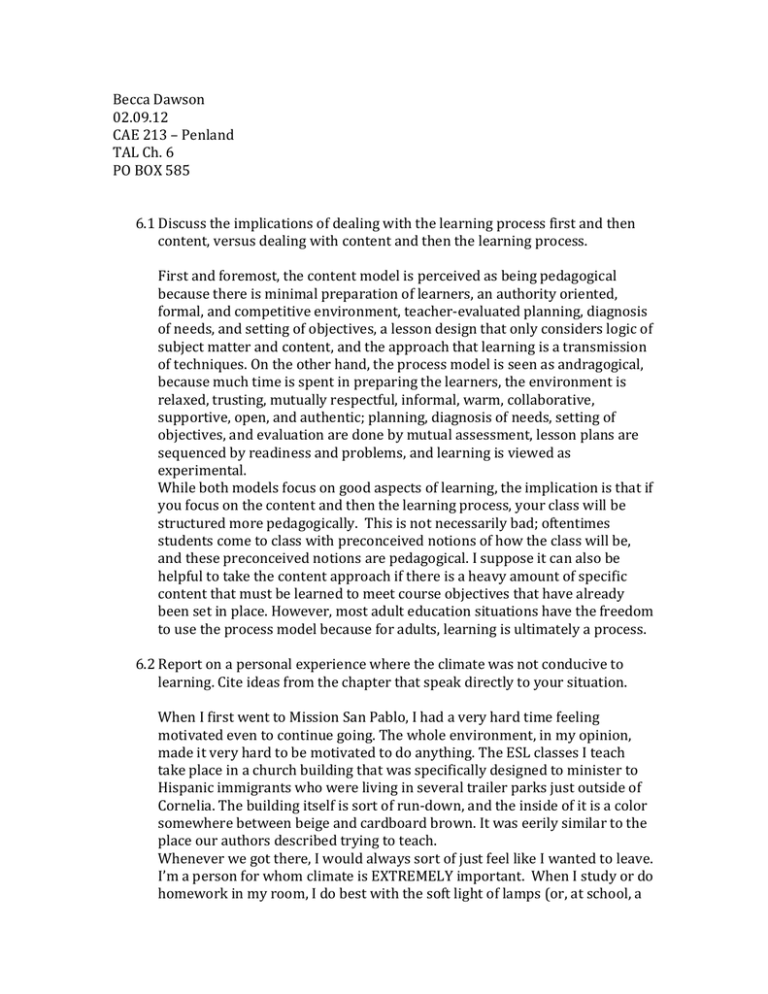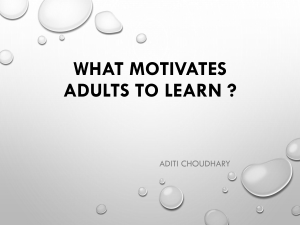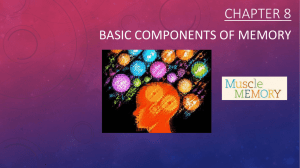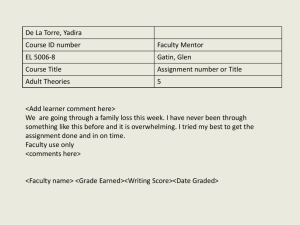Becca Dawson 02.09.12 CAE 213 – Penland TAL Ch. 6 PO BOX
advertisement

Becca Dawson 02.09.12 CAE 213 – Penland TAL Ch. 6 PO BOX 585 6.1 Discuss the implications of dealing with the learning process first and then content, versus dealing with content and then the learning process. First and foremost, the content model is perceived as being pedagogical because there is minimal preparation of learners, an authority oriented, formal, and competitive environment, teacher-evaluated planning, diagnosis of needs, and setting of objectives, a lesson design that only considers logic of subject matter and content, and the approach that learning is a transmission of techniques. On the other hand, the process model is seen as andragogical, because much time is spent in preparing the learners, the environment is relaxed, trusting, mutually respectful, informal, warm, collaborative, supportive, open, and authentic; planning, diagnosis of needs, setting of objectives, and evaluation are done by mutual assessment, lesson plans are sequenced by readiness and problems, and learning is viewed as experimental. While both models focus on good aspects of learning, the implication is that if you focus on the content and then the learning process, your class will be structured more pedagogically. This is not necessarily bad; oftentimes students come to class with preconceived notions of how the class will be, and these preconceived notions are pedagogical. I suppose it can also be helpful to take the content approach if there is a heavy amount of specific content that must be learned to meet course objectives that have already been set in place. However, most adult education situations have the freedom to use the process model because for adults, learning is ultimately a process. 6.2 Report on a personal experience where the climate was not conducive to learning. Cite ideas from the chapter that speak directly to your situation. When I first went to Mission San Pablo, I had a very hard time feeling motivated even to continue going. The whole environment, in my opinion, made it very hard to be motivated to do anything. The ESL classes I teach take place in a church building that was specifically designed to minister to Hispanic immigrants who were living in several trailer parks just outside of Cornelia. The building itself is sort of run-down, and the inside of it is a color somewhere between beige and cardboard brown. It was eerily similar to the place our authors described trying to teach. Whenever we got there, I would always sort of just feel like I wanted to leave. I’m a person for whom climate is EXTREMELY important. When I study or do homework in my room, I do best with the soft light of lamps (or, at school, a lamp and some Christmas lights I’ve hung over my section of the room). In my room here at school, my walls are completely covered: a huge collage of my favorite compelling cross-cultural pictures I’ve collected/taken, a full-size reprint of “Le Chat Noir” by Rodolphe Salis (it’s a French cabaret painting of a black cat, all simple lines and rich, “warm” tones of yellow and red), a collage one of my best friends made for me. I organize my books by color, I have bright handwoven rugs on my floor, I have a general theme of warm colors that I find enhance my mood. And here I was, in a building that looked inside and outside like a cardboard box… doing something I’d never done before and was terrified to do, with students who seemed less motivated than me. It was a hard semester. Luckily now there are some posters on the walls of Mission San Pablo, and I hardly notice the drab settings of the classes. As I’ve been applying the principles of andragogy that I’ve already learned about to my class this semester, the learners themselves have enhanced the climate. 6.3 Why is the idea of program/learning objectives so controversial? Simply put, program/learning objectives are controversial because most of the time, it is left to an authority figure to decide program/learning objectives, and this stands in direct opposition to the principle of andragogy that says that adults have a deep need to be self-directed learners. 6.4 Discuss the purpose and process of program evaluation and then comment on the primary evidence that you think (1) would satisfy the learner, (2) the facilitator, and (3) the agency financially underwriting the program. There are four steps of a good program evaluation. The first step is a reaction evaluation, in which information is gathered about how the participants are responding to program- things such as their favorite and least favorite parts of the program. The second step s a learning evaluation, where data is obtained about the principles, facts, and techniques that were acquired by the participants (NOTE: this should include pretests and posttests). The third step is behavioral evaluation, which includes behavioral changes in the learner before and after the course. The fourth step is a results evaluation, or the results of factors found in routine records of organizations – the effects on turnover, cost, efficiency, frequency of tardiness/absence, etc. Given these four evaluations, a positive learning evaluation would likely satisfy the learner; a mostly positive reaction evaluation, a good learning evaluation, and a good behavioral evaluation would most satisfy me as a facilitator; and a good learning evaluation and results evaluation would most satisfy the agency.







